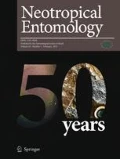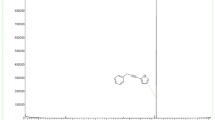Abstract
Plant essential oils have been recognized as significant natural resources for insecticides. Herein, we have assessed the toxicity of the essential oil of Piper aduncum (Piperaceae) against Euschistus heros (F.) (Hemiptera: Pentatomidae), a key soybean pest in Neotropical America. In addition, we have assessed its effect on the performance of egg parasitoids. The essential oil was obtained from the leaves of P. aduncum via hydrodistillation. Subsequently, bioassays of the concentration response to eggs (contact and immersion methods), nymphs, and adults (topical application) were conducted, to assess the lethal effects on the stink bug. We also evaluated the performance of parasitism and adult emergence of egg parasitoids, when the host eggs were treated with essential oil. In the egg bioassay, both exposure methods were efficient for unviable eggs (immersion LC50 = 15.64 mg mL−1; contact LC50 = 21.29 mg mL−1), with the highlight on the immersion method. The bioassay with nymphs indicated a higher toxicity of essential oil, with lower concentrations (LC50 = 11.37 mg mL−1) being required to cause the death of insects. For adults, a reduction in survival of insects was observed, and consequently, there was a reduction in the number of individuals in the next generation. Although the essential oil was toxic to E. heros, it exhibited lower toxicity for egg parasitoids, as there was no effect on parasitism and the emergence of wasps. We discuss likely explanations for such selectivity. In summary, we found that the essential oil was promising for the control of E. heros, because it caused deleterious effects at all development stages of the stink bug and had no effect on parasitism and emergence of the egg parasitoids, which suggested compatibility with biological control.


Similar content being viewed by others
References
Abudulai M, Shepard BM (2003) Effects of neem Azadirachta indica A. Juss on Trissolcus basalis Wollaston (Hymenoptera: Scelionidae), a parasitoid of Nezara viridula L. Hemiptera: Pentatomidae. J Entomol Sci 38:386–397
Abudulai M, Shepard BM, Mitchell PL (2003) Antifeedant and toxic effects on a neem Azadirachta indica (A. Juss) based formulation neemix against Nezara viridula (L.) (Hemiptera: Pentatomidae). J Entomol Sci 38:398–408
Almeida RRP, Souto RNP, Bastos CN, Silva MHL, Maia JGS (2009) Chemical variation in Piper aduncum and biological properties of its dillapiole-rich essential oil. Chem Biodivers 6:1427–1434. doi:10.1002/cbdv.200800212
Assis A, Brito V, Bittencourt M, Silva L, Oliveira F, Oliveira R (2013) Essential oils composition of four Piper species from Brazil. J Essent Oil Res 25:203–209. doi:10.1080/10412905.2013.767755
Austin AD, Johnson NF, Dowton M (2005) Systematics, evolution, and biology of scelionid and platygastrid wasps. Annu Rev Entomol 50:553–582. doi:10.1146/annurev.ento.50.071803.130500
Bernard CB, Krishnamurty HG, Chauret D, Drust T, Philogene BJR, Sanchez-Vindas P, Hasbun C, Poveda L, San-Román L, Arnason JT (1995) Insecticidal defenses of Piperaceae from the neotropics. J Chem Ecol 21:801–814
Biondi A, Zappalà L, Stark JD, Desneux N (2013) Do biopesticides affect the demographic traits of a parasitoid wasp and its biocontrol services through sublethal effects? PLoS One 8:e76548. doi:10.1371/journal.pone.0076548
Boulogne I, Petit P, Ozier-Lafontaine H, Desfontaines L, Loranger-Merciris G (2012) Insecticidal and antifungal chemicals produced by plants: a review. Environ Chem Lett 10:325–347. doi:10.1007/s10311-012-0359-1
Coitinho RLBC, Oliveira JV, Gondim-Junior MGC, Câmara CAG (2011) Toxicidade por fumigação, contato e ingestão de óleos essenciais para Sitophilus zeamais Motschulsky, 1885 (Coleoptera: Curculionidae). Cienc Agrotecnol 35:172–178. doi:10.1590/S1413-70542011000100022
Corrêa-Ferreira BS, Azevedo J (2002) Soybean seed damage by different species of stink bugs. Agric For Entomol 4:145–150. doi:10.1046/j.1461-9563.2002.00136.x
Costa MLM, Borges M, Vilela EF (1998) Biologia reprodutiva de Euschistus heros (F.) (Heteroptera:Pentatomidae). An Soc Entomol Bras 27:559–568. doi:10.1590/S0301-80591998000400008
El-Wakeil NE (2013) Botanical pesticides and their mode of action. Gesunde Pflanzen 65:125–149. doi:10.1007/s10343-013-0308-3
Estrela JLV, Fazolin M, Catani V, Alécio MR, Lima MS (2006) Toxicidade de óleos essenciais de Piper aduncum e Piper hispidinervum em Sitophilus zeamais. Pesq Agrop Brasileira 41:217–222. doi:10.1590/S0100-204X2006000200005
Fazolin M, Estrela JLV, Catani V, Lima MS, Alécio MR (2005) Toxicidade do óleo de Piper aduncum L. a adultos de Cerotoma tingomarianus Bechyné (Coleoptera: Chrysomelidae). Neotrop Entomol 34:485–489. doi:10.1590/S1519-566X2005000300018
Fazolin M, Estrela JLV, Catani V, Alécio MR, Lima MS (2007) Propriedade inseticida dos óleos essenciais de Piper hispidinervum C. DC.; Piper aduncum L. e Tanaecium nocturnum (Barb. Rodr.) Bur. and K. Shum sobre Tenebrio molitor L., 1758. Cienc Agrotecnol 31:113–120. doi:10.1590/S1413-70542007000100017
Foerster LA (2002) Seletividade de inseticidas a predadores e parasitóides.: Controle biológico no Brasil: parasitóides e predadores. In: Parra JRP, Botelho PSM, Corrêa-Ferreira BS, Bento JMS (eds) Controle biológico no Brasil: parasitóides e predadores. São Paulo, pp 95–114
Golin V, Loiácono M, Margaría C, Aquino D (2011) Natural incidence of egg parasitoids of Edessa meditabunda (F.) (Hemiptera: Pentatomidae) on Crotalaria spectabilis in Campo Novo do Parecis, MT, Brazil. Neotrop Entomol 40:617–618. doi:10.1590/S1519-566X2011000500015
Krinski D, Massaroli A (2014) Nymphicidal effect of vegetal extracts of Annona mucosa and Anonna crassiflora (Magnoliales, Annonaceae) against rice stalk stink bug, Tibraca limbativentris (Hemiptera, Pentatomidae). Rev Bras Frutic 36:217–224. doi:10.1590/S0100-29452014000500026
Laumann RA, Moraes MCB, Silva JP, Vieira AMC, Silveira S, Borges M (2010) Egg parasitoid wasps as natural enemies of the neotropical stink bug Dichelops melacanthus. Pesq Agrop Brasileira 45:442–449. doi:10.1590/S0100-204X2010000500002
Maia JGS, Zohhbi MGB, Andrade EHA, Santos AS, Silva MJL, Luz AIR, Bastos CN (1998) Constituents of the essential oil of Piper aduncum L. growing wild in the Amazon region. Flavour Fragance J 13:269–272. doi:10.1002/(SICI)1099-1026(1998070)13:4<269::AID-FFJ744>3.0.CO;2-A
Misni N, Othman H, Sulaiman S (2011) The effect of Piper aduncum Linn. (Family: Piperaceae) essential oil as aerosol spray against Aedes aegypti (L.) and Aedes albopictus Skuse. Trop Biomed 28:249–258
Mitchell PL, Gupta R, Singh AK, Kumar P (2004) Behavioral and developmental effects of neem extracts on Clavigralla scutellaris (Hemiptera: Heteroptera: Coreidae) and its egg parasitoid, Gryon fulviventre (Hymenoptera: Scelionidae). J Econ Entomol 97:916–923. doi:10.1093/jee/97.3.916
Mithofer A, Boland W (2012) Plant defense against herbivores: chemical aspects. Annu Rev Plant Biol 63:431–450. doi:10.1146/annurev-arplant-042110-103854
Morais SM, Facundo VA, Bertini LM, Cavalcanti ESB, Anjos JF, Ferreira SA, Brito ES, Souza-Neto MA (2007) Chemical composition and larvicidal activity of essential oils from Piper species. Biochem Syst Ecol 35:670–675. doi:10.1016/j.bse.2007.05.002
Nerio LS, Olivero-Verbel J, Stashenko E (2010) Repellent activity of essential oils: a review. Bioresour Technol 101:372–378. doi:10.1016/j.biortech.2009.07.048
Orr DB (1988) Scelionid wasps as biological control agents: a review. Fla Entomol 71:506–528
Peres WAA, Corrêa-Ferreira BS (2004) Methodology of mass multiplication of Telenomus podisi Ash. and Trissolcus basalis (Woll.) (Hymenoptera: Scelionidae) on eggs of Euschistus heros (Fab.) (Hemiptera: Pentatomidae). Neotrop Entomol 33:457–462. doi:10.1590/S1519-566X2004000400010
Pinheiro PV, Quintela ED (2010) Efeito inseticida e deterrente do óleo de nim em machos e fêmeas de Oebalus Poecilus (Hemiptera: Pentatomidae). Pesqui Agrop Trop 40:394–400. doi:10.1590/S1983-40632010000400018
Piton LP, Turchen LM, Butnariu AR, Pereira MJB (2014) Natural insecticide based-leaves extract of Piper aduncum (Piperaceae) in the control of stink bug brown soybean. Ciênc Rural 44:1915–1920. doi:10.1590/0103-8478cr20131277
Potzernheim MCL, Bizzo HR, Silva JP, Vieira RF (2012) Chemical characterization of essential oil constituents of four populations of Piper aduncum L. from Distrito Federal, Brazil. Biochem Syst Ecol 42:25–31. doi:10.1016/j.bse.2011.12.025
Prista LN, Alves AC, Morgado RMR (1981) Técnica farmacêutica e farmácia galênica. Calouste Gulbenkian, Lisboa, p 147
R Core Team (2014) R: a language and environment for statistical computing. R Foundation for Statistical Computing. Vienna, Austria. URL http://www.R-project.org/
Riba MJ, Martí J, Sans A (2003) Influence of azadirachtin on development and reproduction of Nezara viridula L. (Het., Pentatomidae). J Appl Entomol 127:37–41. doi:10.1046/j.1439-0418.2003.00684.x
Sahayaraj K, Kalidas S (2011) Evaluation of nymphicidal and ovicidal effect of a seaweed, Padina pavonica (Linn.) (Phaeophyceae) on cotton pest, Dysdercus cingulatus (Fab.). Indian J Geo-Mar Sci 40:125–129
Scott IM, Jensen HR, Philogène BJR, Arnason JT (2007) A review of Piper spp. (Piperaceae) phytochemistry, insecticidal activity and mode of action. Phytochem Rev 7:65–75. doi:10.1007/s11101-006-9058-5
Silva CC, Laumann RA, Blassioli MC, Pareja M, Borges M (2008) Euschistus heros mass rearing technique for the multiplication of Telenomus podisi. Pesq Agrop Brasileira 43:575–580. doi:10.1590/S0100-204X2008000500004
Silva FA, Calizotti GS, Panizzi AR (2011) Survivorship and egg production of phytophagous pentatomids in laboratory rearing. Neotrop Entomol 40:35–38. doi:10.1590/S1519-566X2011000100005
Silva FAC, Silva JJ, Depieri RA, Panizzi A (2012) Feeding activity, salivary amylase activity, and superficial damage to soybean seed by adult Edessa meditabunda (F.) and Euschistus heros (F.) (Hemiptera: Pentatomidae). Neotrop Entomol 41:386–390. doi:10.1007/s13744-012-0061-9
Silva VP, Pereira MJB, Turchen LM (2013) Efeito de extratos vegetais no controle de Euschistus heros (F.) (Hemiptera: Pentatomidae) em lavoura de soja na região sudoeste do Estado de Mato Grosso. Rev Agric 88:185–190
Singha A, Thareja V, Singh AK (2007) Application of neem seed kernel extracts result in mouthpart deformities and subsequent mortality in Nezara viridula (L.) (Hem: Pentatomidae). J Appl Entomol 131:197–201. doi:10.1111/j.1439-0418.2006.01134.x
Smaniotto LF, Gouvea A, Potrich M, Silva ERL, Silva J, Pegorini CS (2013) Selectivity of alternative products to Telenomus podisi Ashmead (Hymenoptera: Scelionidae). Semina Cienc Agrar 34:3295–3306
Sosa-Gomez DR, Silva JJ (2010) Neotropical brown stink bug (Euschistus heros) resistance to methamidophos in Paraná, Brazil. Pesq Agrop Brasileira 45:767–769. doi:10.1590/S0100-204X2010000700019
Souto RNP, Harada AY, Andrade EHA, Maia JGS (2012) Insecticidal activity of Piper essential oils from the amazon against the fire ant Solenopsis saevissima (Smith) (Hymenoptera: Formicidae). Neotrop Entomol 41:510–517. doi:10.1007/s13744-012-0080-6
Souza EM, Cordeiro JR, Pereira MJB (2007) Avaliação da atividade inseticida dos diferentes extratos das sementes de Annona coriacea sobre Dichelops melacanthus (Dallas, 1851). Rev Bras Agroecologia 2:1107–1110
Turchen LM, Golin V, Butnariu AR, Pereira MJB (2014) Selectivity of Annona (Annonaceae) extract on egg parasitoid Trissolcus urichi Crawford, 1913 (Hymenoptera: Platygastridae). Rev Colomb Entomol 40:176–180
Turchen LM, Golin V, Butnariu AR, Guedes RNC, Pereira MJB (2016) Lethal and sublethal effects of insecticides on the egg parasitoid Telenomus podisi (Hymenoptera: Platygastridae). J Econ Entomol 109:84–92. doi:10.1093/jee/tov273
Volpe XLH, Fazolin M, Garcia RB, Magnani RF, Barbosa JC, Miranda MP (2015) Efficacy of essential oil of Piper aduncum against nymphs and adults of Diaphorina citri. Pest Manag Sci. doi:10.1002/ps.4143
Acknowledgments
The authors thanks the Fundação de Amparo a Pesquisa do Estado de Mato Grosso (FAPEMAT) for financial assistance (process number: 163079/2014), the Conselho Nacional de Desenvolvimento Científico e Tecnológico (CNPq) for providing Masters scholarship (process number: 134392/2015-9), and Dr. Norman Johnson for confirmation of species of Telenomus podisi and Trissolcus urichi.
Author information
Authors and Affiliations
Corresponding author
Additional information
Edited by Moisés J Zotti – UFPel
Rights and permissions
About this article
Cite this article
Turchen, L.M., Piton, L.P., Dall’Oglio, E.L. et al. Toxicity of Piper aduncum (Piperaceae) Essential Oil Against Euschistus heros (F.) (Hemiptera: Pentatomidae) and Non-Effect on Egg Parasitoids. Neotrop Entomol 45, 604–611 (2016). https://doi.org/10.1007/s13744-016-0409-7
Received:
Accepted:
Published:
Issue Date:
DOI: https://doi.org/10.1007/s13744-016-0409-7




